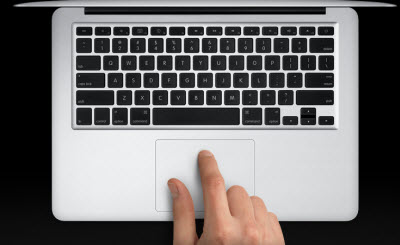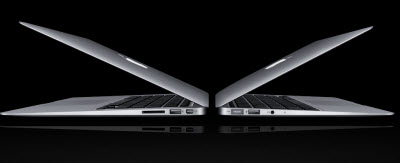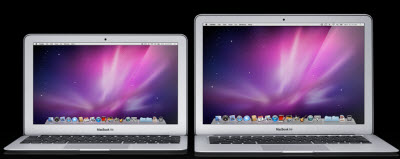 The lines between work and play have blurred in the always-on, digital online age. Smartphones, netbooks, tablets, and other gadgets make it much easier to do work while you’re supposed to be on the run or taking it easy. And they also make it easier to goof off when you’re supposed to be working.
The lines between work and play have blurred in the always-on, digital online age. Smartphones, netbooks, tablets, and other gadgets make it much easier to do work while you’re supposed to be on the run or taking it easy. And they also make it easier to goof off when you’re supposed to be working.
 The new MacBook Air from Apple is one of the devices that sits right at this intersection of work and play. It’s great for entertainment, offering you the full Mac OS operating system and all of its applications for play. But it can also run full web browsers, Microsoft Office, and other work-related applications too. And perhaps a plus for your social life, it makes you look cool while you’re working or playing.
The new MacBook Air from Apple is one of the devices that sits right at this intersection of work and play. It’s great for entertainment, offering you the full Mac OS operating system and all of its applications for play. But it can also run full web browsers, Microsoft Office, and other work-related applications too. And perhaps a plus for your social life, it makes you look cool while you’re working or playing.
I’ve played around with one for a bit, and I like the fact that it stands on this divide. With an iPad, I can sit in front of the TV with the family and browse through entertainment functions. For the most part, everybody knows that I’m just sort of snacking on information while I’m watching TV.
With a MacBook Air, I can pretend to work. Or I can pretend to play. Steve Jobs, chief executive of Apple, described the MacBook Air as a hybrid of the MacBook laptops and the iPad tablet computer. At some point, the MacBook devices will be able to run apps designed to run on the Mac OS. Once again, that helps blur the lines, allowing you to quickly fire up an app while you’re doing something else.
If I were just working, a plain vanilla Windows laptop would be fine. But this MacBook Air is sexy. You can take it someplace and show it off. People will stop and ask you about it. It’s a social tool. And I’ll wager that a lot of people, particularly young folks, aren’t drawing as clear a line between work and play as they used to — and are multitasking much more than they used to do, too.
 The 11.6-inch or 13.3-inch screens are great for sharing, allowing you to show someone what you’re looking at easily. It is just 0.68 inches thick at its thickest part and a tenth of an inch at its thinnest; it weighs just 2.9 pounds and has a precision aluminum case. So the device is much more mobile than past laptops.
The 11.6-inch or 13.3-inch screens are great for sharing, allowing you to show someone what you’re looking at easily. It is just 0.68 inches thick at its thickest part and a tenth of an inch at its thinnest; it weighs just 2.9 pounds and has a precision aluminum case. So the device is much more mobile than past laptops.
The MacBook Air’s all-flash memory storage is an important step forward. Normally, laptops and desktops use hard disk drives. They take a while to boot up. Since it uses faster chip-based flash technology, the MacBook Air can wake up from sleep mode instantly or boot up from a cold start in about 17 seconds. It takes about six seconds to shut down. The flash memory is about twice as fast as a hard drive.
And Apple places the flash memory chips directly on the system board (motherboard), so it doesn’t have bulky packaging. That allows it to have bigger batteries. Battery life is five hours (for 11.6-inch model) to seven hours (13.3-inch model) with heavy wireless use; standby time is 30 days.
 That means you can whip it open while you’re doing something else and get to what you want quickly. That’s a requirement for any device that purports to straddle the line between work and play.
That means you can whip it open while you’re doing something else and get to what you want quickly. That’s a requirement for any device that purports to straddle the line between work and play.
The $999 model comes with an 11.6-inch LED backlit screen, Nvidia GeForce 320M graphics, a 1.4 gigahertz Intel Core 2 Duo processor, and 64 gigabytes of flash memory storage. Other models cost $1,199 for 128 gigabytes of storage; the 13-inch model with 128 gigabytes costs $1,299, and the 13-inch with 256 gigabytes costs $1,599. Those prices aren’t as out of reach as the original MacBook Air that was introduced in January, 2008, at $1,800.
 This device is also more functional than the older MacBook Air. It has Apple’s FaceTime video camera on it, allowing you to make video phone calls to other MacBook Air users or to those with iPhone 4 phones. That makes it more unique than some of the laptops or netbooks out there, though Skype video calling is still an option for many rival machines.
This device is also more functional than the older MacBook Air. It has Apple’s FaceTime video camera on it, allowing you to make video phone calls to other MacBook Air users or to those with iPhone 4 phones. That makes it more unique than some of the laptops or netbooks out there, though Skype video calling is still an option for many rival machines.
The MacBook Air comes with Apple’s Snow Leopard version of the Mac OS X operating system and the iLife ’11 software suite for editing videos or photos and for making music.
Besides having no hard drive, the device doesn’t have an optical DVD drive. That means you can’t play DVD movies while on the run, but with applications such as Netflix, Hulu, and Vudu, that’s not such a big deal anymore. You can stream movies or TV shows over the air to the device via Wi-Fi connectivity. While it does have an Nvidia graphics chip for good 3D graphics, you’re not likely going to play heavy-duty games on this device.
 Of the two models, the 13-inch has more features, such as an SD card slot for easily loading photos, On the smaller model, you have to rely on universal serial bus (USB) 2.0 ports or Bluetooth wireless for photo transfers. The MacBook Air has a huge multi-touch trackpad that lets you pinch, swipe, drag, rotate and scroll.
Of the two models, the 13-inch has more features, such as an SD card slot for easily loading photos, On the smaller model, you have to rely on universal serial bus (USB) 2.0 ports or Bluetooth wireless for photo transfers. The MacBook Air has a huge multi-touch trackpad that lets you pinch, swipe, drag, rotate and scroll.
You can connect the device to a 27-inch desktop display. Since the devices have a relatively small amount of storage, you’re probably going to need to store most of your music, videos, photos and documents on a desktop computer still. So we’re not quite at the day when all you need is just a laptop. But the MacBook Air is pretty close to being the only computing device you’ll need, if you really wanted to have just one.
Apple took a long time to come out with this redesign. If it were any other company, it would probably be far behind the other computer makers who come up with lots of different designs every quarter, hoping that one would appeal to a certain kind of crowd. But by taking its time, Apple has done a great job. It has taken the art of designing the hybrid computer — the kind that blends work and play — and moved it forward by leaps and bounds.

